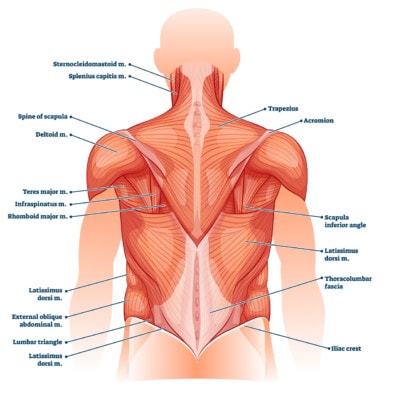Your Back Problem May Be Destroying Back Muscles
The back muscles are the red-headed stepchild of the spine. While physicians have had a disc fetish for years and have given much attention to other structures, such as the facet joints, the muscles have been largely left out of the equation. However, more and more research continues to show that this is a bad idea. Let’s review some new research.
Understanding Back Muscle Anatomy
The intricate group of back muscles that define the back consist of three layers: superficial, intermediate, and deep. While all work together to support the back, each has its own specific job.
The muscles found in each layer of the spine are different for each part. For example, in the upper back, the superficial layer consists of a group of four muscles (i.e., rhomboids, trapezius, latissimus dorsi, and levator scapula) that you can see and feel on the surface. These muscles assist with head, neck, and arm movement. Staying with the theme of the upper back, a bit deeper is the intermediate layer (aka erector spinae) of back muscles. This layer consists of three muscle groups (iliocostalis, longissimus, and spinalis) that support extension of the spine, head rotation, and side-to-side bending. They also provide a counterbalance to the abdominal muscles, which helps maintain proper body posture.

VectorMine/Shutterstock
The deep layer of back muscles is buried close to the spine, resting beneath the intermediate back muscles. This group consists of three muscle groups (semispinalis, multifidus, and rotatores). Collectively, they stabilize the spinal column, and here it’s important to feature the multifidus. Watch my video below for more information on the multifidus muscle:
We already know that studies have associated atrophy (or wasting) of the multifidus with not only back pain but also sciatica. Now a new study examines back muscle strength in those with spinal disorders and its connection to loss of muscle mass in general with aging. Let’s review.
The Decline of Back Muscle Strength and Mass in Spinal Conditions
The purpose of the new study was to investigate associations between back muscle strength and muscle mass in an elderly population (230 participants aged 65 and older) with spinal disorders. Measurements included muscle and grip strength, muscle mass, and gait speed. From this, researchers determined if participants had loss of muscle mass or loss of muscle strength or neither.
The results? The study found that while loss of muscle mass is common with aging as activity declines, adding a back condition to the mix increases the risk of muscle loss and weakening as we age. The research suggested that keeping the muscles active, even in the presence of aging and a spinal disorder, may keep the back stronger and, therefore, decrease the risk of muscle loss.
One way to keep your back muscles active is to continue to exercise as you age. You can do this by proactively addressing any spinal issues, such as a disc or nerve problem, as it presents and certainly before it gets worse.
More Problems with Back Muscle Wasting and Weakening
Healthy back muscles are important not just for our back but for our entire body. The spinal column has a big job; it keeps us straight and upright, but it also protects our body’s entire nervous system network. Disruption of just one nerve at the spine can disrupt function to any structure that nerve branch supplies (e.g., a pinched low back nerve can cause pain and functional problems as far down as our foot). While there are many spinal structures that work in collaboration to keep our back and body healthy, muscles are a major contributor as they are the key to proper stability and support. Let’s take a look at what can happen when our back muscles begin to waste away or weaken:
- Spinal nerves can be irritated by a herniated or bulging disc, which can disrupt the nerve supply to the multifidus muscle and cause both atrophy of the muscle and back pain.
- Wasting away of the multifidus has been linked to a variety of disruptions in back function.
- Surgery, such as spinal fusion, can heavily damage the multifidus muscle as well as the erector spinae muscles at the intermediate level of the back.
The upshot? The research continues to mount showing that the muscles that stabilize the spine are critical to a healthy back. Hence, paying attention to what’s going on with these muscles is a critical part of treating back pain. If your doctor has never once discussed the status of the deep muscles, like the multifidus, find a new doctor.

NOTE: This blog post provides general information to help the reader better understand regenerative medicine, musculoskeletal health, and related subjects. All content provided in this blog, website, or any linked materials, including text, graphics, images, patient profiles, outcomes, and information, are not intended and should not be considered or used as a substitute for medical advice, diagnosis, or treatment. Please always consult with a professional and certified healthcare provider to discuss if a treatment is right for you.
